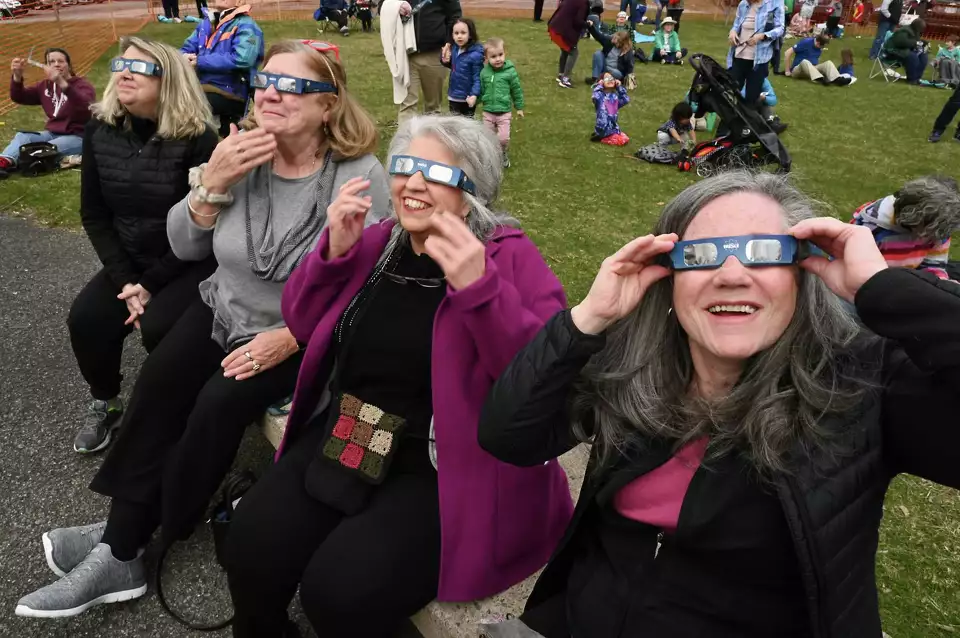In those low-tech pre-internet days, I was often called upon as a Verizon spokesman to relate how world events affected phone call volumes. Two of my favorite happenings were the O.J. Simpson trial verdict in 1995 and the 1981 wedding of Luke and Laura on the soap opera “General Hospital.” In both cases, phone call traffic dropped off considerably as viewers watched the events on TV, then rose sharply afterward as people called each other to talk about what they had witnessed. It was, I mused to reporters then, a way of taking the pulse of the country.
Commentary: All eyes on the sky
The total solar eclipse was an opportunity to live in the moment, no cellphone required — except for taking photographs
By
We now have a new piece of data that helps us understand the world around us and, even better, how we live.
Earlier this week millions of us gasped in awe as we watched a unique celestial event. Temporarily abandoning the flickering light, persistent beeps, TikTok videos, social media postings and “urgent” emails on our computer screens, we walked outside — or even drove hundreds of miles — to watch our moon totally block out the sun for a few minutes.
The World Wide Web took notice. As reported by The New York Times on April 9, internet traffic during peak totality dropped by at least 40 percent and in some places by 60 percent. The data, provided by cloud-computing service Cloudflare, was especially apparent in areas across the country in the path of totality that led to sudden, mystical midday darkness.

While researchers and computer science experts far smarter than I will digest and better interpret this information in the coming months, I look at the event as having a simple, positive impact: It got us away from computers and digital connectivity for a while.
I’ll also admit the digital connections were not totally severed. I drove over 150 miles from my Clifton Park home to see totality myself in the small upstate town of Lowville, just west of the Adirondack Mountains. As I wandered the open fields of the Lewis County Fairgrounds, I kept pulling my smartphone out for two reasons: I constantly checked weather sites for the incoming clouds that spoiled my opportunity for clear-sky photos, and of course I used the phone’s camera to capture glimpses of the sky and my surroundings.
I was not alone. Hundreds of people attending the local watch event around me looked skyward with smartphones in their hands. Perhaps some of them were even relaying their impressions of the event to friends and family elsewhere.
While a heavy layer of clouds prevented me from capturing totality photos — especially the images of the sun’s corona I so eagerly sought — the afternoon on April 8 was far from a total bust for me. While I had a sense of what would happen at totality, I was woefully unprepared for the spectacle. Suddenly, it was as though someone turned off the lights. Bright daylight was replaced with an eerie, mysterious darkness. Sensors on nearby fairground buildings leaped into action, turning on outside lights. I could only see those fellow skywatchers close to me. Around me a hearty cheer went up, and applause, as we soaked in the suddenly chilly darkness. A few people wept. Some children screamed. I was moved to the point of tears.
Instead of photos of a cloudy sky, I held up my smartphone to capture scenes of darkness, which I’d later post online and compare to the broad-daylight photos of a few minutes earlier.
And then it was over.
I exchanged a few “wows” with fellow eclipse chasers before I started the long walk back to my car. And during the agonizing four-hour drive home that night, I alternated between anger over the traffic and thankfulness for witnessing such a rare event with my own eyes.
After I got home, I didn’t turn my computer on for two days.
Mark Marchand, a writer and author, formerly taught in the journalism program at the University at Albany.
